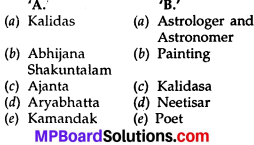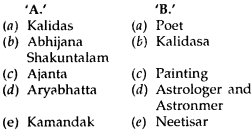MP Board Class 6th Social Science Solutions Chapter 19 The Gupta Period and The Post-Gupta Period
MP Board Class 6th Social Science Chapter 19 Text Book Exercise
Answer the following questions
Question 1.
Question (a)
Name the famous rulers of the Gupta Dynasty?
Answer:
The first famous ruler of the Gupta dynasty was Chandragupta – I. He found his kingdom in about 320 A.D.
Question (b)
Which kingdoms were conquered by Samudragupta?
Answer:
Samudragupta was the son of Chandragupta – I. He was a successful ruler and a great military genius. His court poet Harishena wrote a glowing account of the military exploits of his patron. He proceeded on a long campaign which brought him the following victories:
1. Conquests of Delhi and West Uttar Pradesh:
Samudragupta defeated four, kings of Northern India and added the territories of the present Delhi and Western Uttar Pradesh of his kingdom.
2. Conquests of Orissa, Andhra and Tamil Nadu:
He fought against a number of kings in Deccan and South India, such as those in Orissa, Andhra and Tamil Nadu.
3. Assam, the Ganga Delta, Nepal and Northern India:
He received tributes from the kings of Assam, the Ganga delta, Nepal and northern India and from the nine tribal republics of Rajasthan, from the Kushana, the Shakas and the Ceylon kings.
Moreover, he campaigned against kings in eastern India. He also attacked the forest tribes in the Deccan. Above all, Samudra – gupta was never defeated. Thus, by his military exploits, he unified the greater part of India under his banner and his power was felt in a much larger area.
Main source of our knowledge about Samudragupta’s conquests is from an inscription engraved on a pillar at Allahabad, which describes his achievement.
![]()
Question (c)
In how many parts was the Gupta empire divided?
Answer:
The Gupta empire was divided into provinces for running the administration smoothly. The provinces were further divided into districts. The lowest unit of the administration was the village. In this way the administration was well planned.
Each province was governed by an Uparika Maharaj. The districts, called the Vishayas, were placed under a Vishaypati. The village head man along with the elders of the village looked after the village administration.
Question (d)
Describe the victories of Harsha vardhana?
Answer:
Harsha vardhana made Kannauj his capital and thus Thanesvara and Kannauj became one. Harsha conquered Punjab, Eastern Rajasthan, Assam and regions in the Gangetic valleys and annexed them to his kingdom. Harsha’s empire extended over Magadha, Eastern Bengal, Orissa, Gujarat, Saurashtra, Sindh and Malwa.
Question (c)
Name the famous writers of the Gupta Period?
Answer:
The famous writers of the Gupta Period were Kalidasa, Acharya Vyasa, Kamandak and Varahmihir.
Question (f)
Name the states conquered by Chandragupta – II?
Answer:
Chandragupta – II conquered Malwa, Soupare, the area beyond the seven rivers of Punjab, the coast of the Arabian Sea, Assam, Bengal, the valleys of the Himalayas and the banks of the river Narmada in the South.
![]()
Answer the following questions in detail:
Question 2.
Question (a)
The Gupta Period is known as the ‘golden period’ in Indian History. Explain?
Answer:
The citizen of Gupta period were happy and rich. The emperor was just so the citizens were also honest and followed the law of the state. Trade was highly developed in the Gupta Period. Trade was carried on at the National and International level. Land and water routes were used for trade and commerce. Mathura, Vidisha, Koshambi, Ujjain, Gaya, Madurai, Jamralipta and Banaras were the main centres of trade.
Trade was carried on with Burma, Kampuchia, Suvarabhoomi and other countries in South – East Asia. The society was developed due to the development of trade. Life was peaceful. Therefore, the Gupta period is known as the ‘Golden Period.’
Question (b)
Explain the political and social conditions in 300 A.D. to 800 A.D?
Answer:
Most of the people were vegetarians. The society was divided into castes. The Brahamans, Kshatriyas, Vaishya, Shudra and other castes were well established as social groups. However, intercaste marriages were in practice. Most of the castes lived together but there was a category which was considered untouchable.
![]()
Question 3.
Fill in the blanks:
- The father of Chandragupta-II was …………………….
- …………………. was a Chinese traveller.
- Meghdoot was written by ………………..
- …………………. situated in Mehrauli.
Answer:
- Samudragupta
- Hiuen – Tsang
- Kalidasa
- Iron pillar
Question 4.
Match the following:

Answer:

![]()
Project Work
Question 1.
Prepare a list of writers, mathematicians, astrologists and astronomists and astrologists of the Gupta period?
Answer:
Kalidasa, Acharya Vyasa, Kamandak and Varahmihir.
Question 2.
Prepare a list of the literary works of the Gupta Period?
Answer:
Do yourself.
Question 3.
Prepare a list of the main kings of the Gupta Period?
Answer:
Chandragupta – I, Samudragupta, Chandragupta – II, Kumargupta and Skandagupta are the main kings of the Gupta Period.